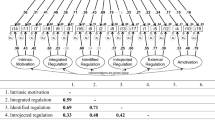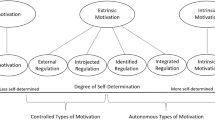Abstract
Self-determination Theory differentiates various types of motivation, each of which have different consequences for well-being and behavior. Despite broad agreement concerning the nature of different types of motivation, numerous scoring methods, each of which rely on different assumptions, are commonly practiced. These practices range from a relative autonomy index that collapses all types of motivation into a single index, higher-order models grouping subscales into a two-factor solution, to multi-factorial approaches examining all motivation types as separate constructs. Existing evidence has not empirically compared these methods or clearly favored the use of one over another. We review each method and further investigate the advantages and disadvantages of each approach by directly comparing a range of commonly utilized scoring methods, as well as recently developed methods across six independent samples from various life domains to determine their effectiveness. Results generally favor multidimensional methods (e.g., exploratory structural equation modeling, B-ESEM, and CFA) as more comprehensive scoring practices as they maximize construct relevant information. However, selection of an ideal method will rely on theoretical congruence between methodology and research questions.

Similar content being viewed by others
References
Abramis, D. J. (1994). Relationship of job stressors to job performance: Linear or inverted-u? Psychological Reports,75, 547–558.
Asparouhov, T., & Muthén, B. (2009). Exploratory structural equation modeling. Structural Equation Modeling: A Multidisciplinary Journal,16(3), 397–438.
Bartholomew, K. J., Ntoumanis, N., Ryan, R. M., & Thøgersen-Ntoumani, C. (2011). Psychological need thwarting in the sport context: Assessing the darker side of athletic experience. Journal of Sport and Exercise Psychology,33(1), 75–102.
Bono, J. E., & Judge, T. A. (2003). Self-concordance at work: Understanding the motivational effects of transformational leaders. Academy of Management Journal,46, 554–571.
Burton, K. D., Lydon, J. E., D'Alessandro, D. U., & Koestner, R. (2006). The differential effects of intrinsic and identified motivation on well-being and performance: Prospective, experimental, and implicit approaches to self-determination theory. Journal of Personality and Social Psychology,91(4), 750.
Chatzisarantis, N. L., Hagger, M. S., Biddle, S. J., Smith, B., & Wang, J. C. (2003). A meta-analysis of perceived locus of causality in exercise, sport, and physical education contexts. Journal of Sport and Exercise Psychology,25(3), 284–306.
Chemolli, E., & Gagné, M. (2014). Evidence against the continuum structure underlying motivation measures derived from self-determination theory. Psychological Assessment,26(2), 575.
Clifford, M. M. (1988). Failure tolerance and academic risk-taking in ten-to twelve-year-old students. British Journal of Educational Psychology,58(1), 15–27.
DeWitte, H., Hooge, J., Vandoorne, J., & Glorieux, I. (2001). Prettig werken in een gezonde samenleving. Omvang, verschillen en gevolgen van arbeidstevredenheid in Vlaanderen. In Administratie Planning en Statistiek (Ed.), Vlaanderen gepeild! De Vlaamse overheid en burgeronderzoek 2001 (pp. 73–98). Brussel: Ministerie van de Vlaamse Gemeenschap
Diener, E. D., Emmons, R. A., Larsen, R. J., & Griffin, S. (1985). The satisfaction with life scale. Journal of Personality Assessment,49(1), 71–75.
Edwards, J. R. (2001). Ten difference score myths. Organizational Research Methods,4, 265–287. https://doi.org/10.1177/109442810143005.
Gagné, M., Forest, J., Vansteenkiste, M., Crevier-Braud, L., Van den Broeck, A., Aspeli, A. K., … Halvari, H. (2015). The Multidimensional Work Motivation Scale: Validation evidence in seven languages and nine countries. European Journal of Work and Organizational Psychology, 24(2), 178-196.
Gerhart, B., & Fang, M. (2014). Pay for (individual) performance: Issues, claims, evidence and the role of sorting effects. Human Resource Management Review,24(1), 41–52.
Gerhart, B., & Fang, M. (2015). Pay, intrinsic motivation, extrinsic motivation, performance, and creativity in the workplace: Revisiting long-held beliefs. Annual Review of Organizational Psychology & Organizational Behavior,2(1), 489–521.
Gillet, N., Gagné, M., Sauvagère, S., & Fouquereau, E. (2013). The role of supervisor autonomy support, organizational support, and autonomous and controlled motivation in predicting employees' satisfaction and turnover intentions. European Journal of Work and Organizational Psychology,22(4), 450–460.
Griffin, M. A., Neal, A., & Parker, S. K. (2007). A new model of work role performance: Positive behavior in uncertain and interdependent contexts. Academy of Management Journal,50(2), 327–347.
Grolnick, W. S., & Ryan, R. M. (1989). Parent styles associated with children's self-regulation and competence in school. Journal of Educational Psychology,81(2), 143.
Guay, F., Mageau, G. A., & Vallerand, R. J. (2003). On the hierarchical structure of self-determined motivation: A test of top-down, bottomup, reciprocal, and horizontal effects. Personality and Social Psychology Bulletin,29, 992–1004.
Guay, F., Morin, A. J., Litalien, D., Valois, P., & Vallerand, R. J. (2015). Application of exploratory structural equation modeling to evaluate the academic motivation scale. The Journal of Experimental Education,83(1), 51–82.
Howard, J. L., Gagné, M., & Bureau, J. S. (2017). Testing a continuum structure of self-determined motivation: A meta-analysis. Psychological Bulletin,143(12), 1346.
Howard, J. L., Gagné, M., Morin, A. J., & Forest, J. (2018). Using bifactor exploratory structural equation modeling to test for a continuum structure of motivation. Journal of Management,44, 2638–2664.
Johns, G. (1981). Difference score measures of organizational behavior variables: A critique. Organization Behavior and Human Performance,27, 443–463.
Li, F. (1999). The exercise motivation scale: Its multifaceted structure and construct validity. Journal of Applied Sport Psychology,11(1), 97–115.
Litalien, D., Morin, A. J., Gagné, M., Vallerand, R. J., Losier, G. F., & Ryan, R. M. (2017). Evidence of a continuum structure of academic self-determination: A two-study test using a bifactor-ESEM representation of academic motivation. Contemporary Educational Psychology,51, 67–82.
Losier, G. F., & Koestner, R. (1999). Intrinsic versus identified regulation in distinct political campaigns: The consequences of following politics for pleasure versus personal meaningfulness. Personality and Social Psychology Bulletin,25, 287–298.
Losier, G. F., Vallerand, R. J., & Blais, M. R. (1993). Construction et validation de l'Échelle des Perceptions de Compétence dans les Domaines de Vie (EPCDV). Science et Comportement,23, 1–16.
Mael, F. A., & Tetrick, L. E. (1992). Identifying organizational identification. Educational and Psychological Measurement,52(4), 813–824.
Marsh, H. W., Morin, A. J., Parker, P. D., & Kaur, G. (2014). Exploratory structural equation modeling: An integration of the best features of exploratory and confirmatory factor analysis. Annual Review of Clinical Psychology,10, 85–110.
Morin, A. J. S., Arens, A., & Marsh, H. (2016a). A bifactor exploratory structural equation modeling framework for the identification of distinct sources of construct-relevant psychometric multidimensionality. Structural Equation Modeling,23, 116–139.
Morin, A. J. S., Marsh, H. W., & Nagengast, B. (2013). Exploratory structural equation modeling: An introduction. In G. R. Hancock & R. O. Mueller (Eds.), Structural equation modeling: A second course (2nd ed., pp. 395–436). Greenwich, CT: IAP.
Morin, A. J. S., Meyer, J. P., Creusier, J., & Biétry, F. (2016b). Multiple-group analysis of similarity in latent profile solutions. Organizational Research Methods,19, 231–254.
Morrison, E. W. (1994). Role definitions and organisational citizenship behaviour: The importance of the employee's perspective. Academy of Management Journal,37, 1543–1567.
Mullan, E., Markland, D., & Ingledew, D. K. (1997). A graded conceptualisation of self-determination in the regulation of exercise behaviour: Development of a measure using confirmatory factor analytic procedures. Personality and Individual Differences,23(5), 745–752.
Muthén, L. K., & Muthén, B. (2015). Mplus: The comprehensive modelling program for applied researchers: user’s guide, 5. Los Angeles, CA: Muthen & Muthen.
Ng, J. Y., Ntoumanis, N., Thøgersen-Ntoumani, C., Deci, E. L., Ryan, R. M., Duda, J. L., et al. (2012). Self-determination theory applied to health contexts: A meta-analysis. Perspectives on Psychological Science,7(4), 325–340.
Pelletier, L. G., Fortier, M. S., Vallerand, R. J., & Briere, N. M. (2001). Associations among perceived autonomy support, forms of self-regulation, and persistence: A prospective study. Motivation and Emotion,25(4), 279–306.
Pelletier, L. G., Rocchi, M. A., Vallerand, R. J., Deci, E. L., & Ryan, R. M. (2013). Validation of the revised sport motivation scale (SMS-II). Psychology of Sport and Exercise,14(3), 329–341.
Pelletier, L. G., Tuson, K. M., Green-Demers, I., Noels, K., & Beaton, A. M. (1998). Why are you doing things for the environment? The motivation toward the environment scale (mtes) 1. Journal of Applied Social Psychology,28(5), 437–468.
Phillips, L. A., & Johnson, M. A. (2018). Interdependent effects of autonomous and controlled regulation on exercise behavior. Personality and Social Psychology Bulletin,44(1), 49–62.
Porath, C., Spreitzer, G., Gibson, C., & Garnett, F. G. (2012). Thriving at work: Toward its measurement, construct validation, and theoretical refinement. Journal of Organizational Behavior,33(2), 250–275.
Reeve, J. (2016). A grand theory of motivation: Why not? Motivation and Emotion,40(1), 31–35.
Ryan, R. M., & Connell, J. P. (1989). Perceived locus of causality and internalization: Examining reasons for acting in two domains. Journal of Personality and Social Psychology,57(5), 749–761.
Ryan, R. M., & Deci, E. L. (2000). Intrinsic and extrinsic motivations: Classic definitions and new directions. Contemporary Educational Psychology,25(1), 54–67.
Ryan, R. M., & Deci, E. L. (2017). Self-determination theory: Basic psychological needs in motivation, development, and wellness. New York: Guilford Publications.
Ryan, R. M., & Frederick, C. (1997). On energy, personality, and health: Subjective vitality as a dynamic reflection of well-being. Journal of Personality,65(3), 529–565.
Schaufeli, W. B., & Bakker, A. B. (2003). UWES-Utrecht Work Engagement Scale: Test manual. Unpublished manuscript, Department of Psychology, Utrecht University.
Schaufeli, W. B., & van Dierendonck, D. (1993). The construct validity of two burnout measures. Journal of Organizational Behavior,14, 631–647.
Sheldon, K. M., Osin, E. N., Gordeeva, T. O., Suchkov, D. D., & Sychev, O. A. (2017). Evaluating the dimensionality of self-determination theory’s relative autonomy continuum. Personality and Social Psychology Bulletin,43(9), 1215–1238.
Skrondal, A., & Laake, P. (2001). Regression among factor scores. Psychometrika,66, 563–576.
Tonidandel, S., & LeBreton, J. M. (2011). Relative importance analysis: A useful supplement to regression analysis. Journal of Business and Psychology,26(1), 1–9.
Tonidandel, S., & LeBreton, J. M. (2015). RWA web: A free, comprehensive, web-based, and user-friendly tool for relative weight analyses. Journal of Business and Psychology,30(2), 207–216.
Vasconcellos, D., Parker, P. D., Hilland, T., Cinelli, R., Owen, K. B., Kapsal, N., … Lonsdale, C. (2019). Self-determination theory applied to physical education: A systematic review and meta-analysis. Journal of Educational Psychology. 10.1037/edu0000420.
Vallerand, R. J., Blais, M. R., Brière, N. M., & Pelletier, L. G. (1989). Construction et validation de l'échelle de motivation en éducation (EME). Canadian Journal of Behavioural Science/Revue Canadienne des Sciences du Comportement,21(3), 323–349.
Vallerand, R. J., Pelletier, L. G., Blais, M. R., Briere, N. M., Senécal, C., & Vallieres, E. F. (1992). The academic motivation scale: A measure of intrinsic, extrinsic, and amotivation in education. Educational and Psychological Measurement,52, 1003–1017.
Vlachopoulos, S. P., Katartzi, E. S., Kontou, M. G., Moustaka, F. C., & Goudas, M. (2011). The revised perceived locus of causality in physical education scale: Psychometric evaluation among youth. Psychology of Sport and Exercise,12(6), 583–592.
Acknowledgements
Part of this research was funded through an Australian Research Council grant awarded to the second author (LP150100417).
Author information
Authors and Affiliations
Corresponding author
Additional information
Publisher's Note
Springer Nature remains neutral with regard to jurisdictional claims in published maps and institutional affiliations.
Electronic supplementary material
Below is the link to the electronic supplementary material.
Rights and permissions
About this article
Cite this article
Howard, J.L., Gagné, M., Van den Broeck, A. et al. A review and empirical comparison of motivation scoring methods: An application to self-determination theory. Motiv Emot 44, 534–548 (2020). https://doi.org/10.1007/s11031-020-09831-9
Published:
Issue Date:
DOI: https://doi.org/10.1007/s11031-020-09831-9




